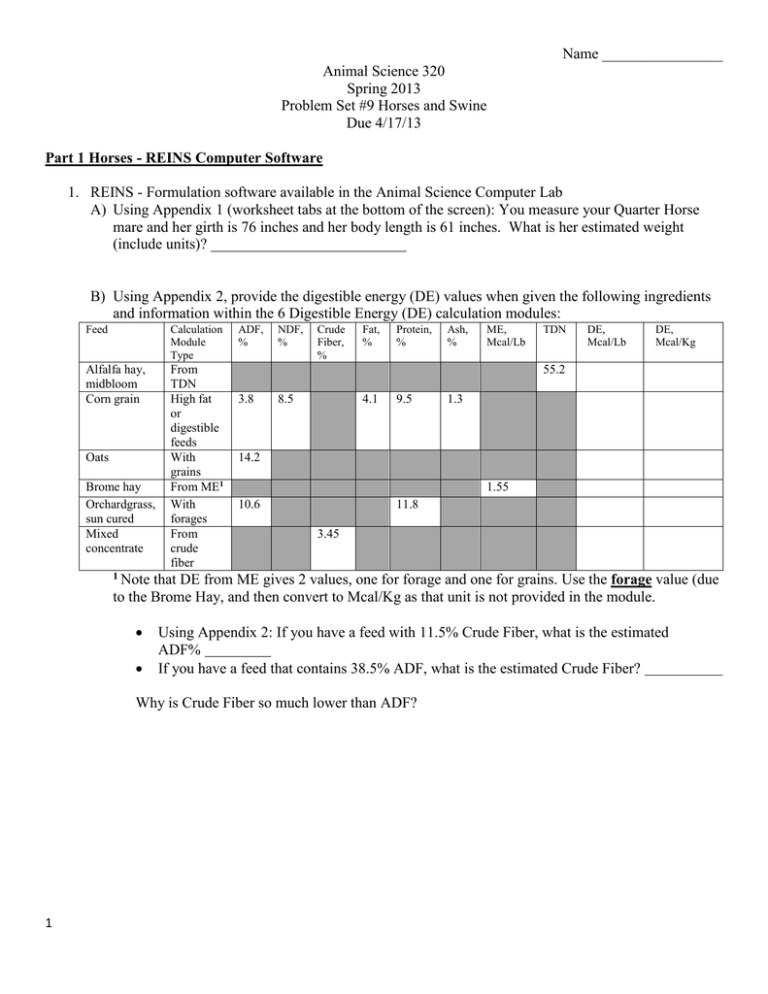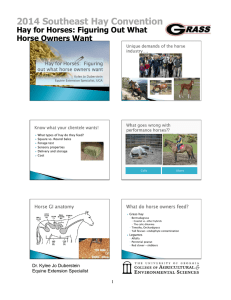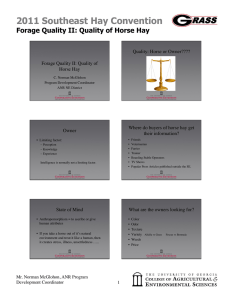Name ________________ Animal Science 320 Spring 2013 Problem Set #9 Horses and Swine
advertisement

Name ________________ Animal Science 320 Spring 2013 Problem Set #9 Horses and Swine Due 4/17/13 Part 1 Horses - REINS Computer Software 1. REINS - Formulation software available in the Animal Science Computer Lab A) Using Appendix 1 (worksheet tabs at the bottom of the screen): You measure your Quarter Horse mare and her girth is 76 inches and her body length is 61 inches. What is her estimated weight (include units)? B) Using Appendix 2, provide the digestible energy (DE) values when given the following ingredients and information within the 6 Digestible Energy (DE) calculation modules: Feed Calculation Module Type Alfalfa hay, midbloom Corn grain From TDN High fat or digestible feeds With grains From ME1 With forages From crude fiber Oats Brome hay Orchardgrass, sun cured Mixed concentrate ADF, % NDF, % Crude Fiber, % Fat, % Protein, % Ash, % ME, Mcal/Lb TDN DE, Mcal/Lb DE, Mcal/Kg 55.2 3.8 8.5 4.1 9.5 1.3 14.2 1.55 10.6 11.8 3.45 1 Note that DE from ME gives 2 values, one for forage and one for grains. Use the forage value (due to the Brome Hay, and then convert to Mcal/Kg as that unit is not provided in the module. Using Appendix 2: If you have a feed with 11.5% Crude Fiber, what is the estimated ADF% If you have a feed that contains 38.5% ADF, what is the estimated Crude Fiber? Why is Crude Fiber so much lower than ADF? 1 C) Using Appendix 3, you estimate the mature weight of your quarter horse foal to be 1,125 Lb. What do you estimate the daily lean body weight gain in pounds per day to be at the following milestones and what are the corresponding estimated body weights in pounds: 4 months = (up to 4 months value) body weight = 6 months = body weight = 12 months = body weight = 18 months = body weight = 2 years = body weight = D) Using the Feeds Tab, Transfer the following feeds by placing a 1, 2 or 3 next to each in the “Select Feeds” list and then clicking “transfer” in the upper left: Troubleshooting: if nothing happens when you click "transfer", you may get a security message indicating "some content has been disabled". You will need to select "enable" in the options bar that pops up toward the top of the screen. Oats, whole 32 (#41) Bermudagrass hay, mature (#83) Corn, cracked dry (#25) In the formulate tab, enter the following parameters under Step 1: Date Start = 4/1/13 Date End = 4/30/13 Animal Type = horse Gender = mare Age = mature BCS = 5 Desired BCS change = maintain a. What is the suggested DMI Feed intake? labeled “Feed Intake (DM basis)” Exercise = Light Reproduction = none Current body weight = 1,125 Lb Growth = 0 Avg. Temp = 50 degrees F Maintenance = 0 (Lb/head) Enter this value in the cell b. In Step 2, Set the following Minimum values for nutrients to balance: DE – Mcal/Lb = 1.04 CP% = 7.0 NDF% = 40 Ca% = 0.23 P% = 0.11 Set the following Maximums Fat = 10.0 Starch = 20.0 2 c. In Step 3, you should see your 3 diet ingredients listed under “feedstuff”. If not, you will need to go back to the “feeds” tab and number the feeds and click “transfer”. You do not need to do anything else under Step 3. d. In Step 4, set the “pounds as fed” next to each ingredient as 3, 2.5 and 17 for oats, corn, and bermudagrass hay, respectively. Check to make sure that your DM Intake at the top (black box) match between the estimated target and the actual intakes (As Fed numbers might vary slightly but DMI should be the same and should match the DMI value from Step 1 that you indicated in answer "a" above). e. Fill in the nutrient concentrations provided by this formulation: DE – Mcal /lb Crude Protein, % NDF, % Starch, % Fat, % Calcium, % Phosphorus, % Part 1 Horses – Hand Calculations A lightly worked horse (ridden 3-5 times weekly), weighing 1,100 pounds requires 20.0 Mcal/day of DE, 699 g of CP, 30 g Ca, and 18 g P. The horse is consuming 1.75% of its body weight as orchardgrass hay. Feedstuffs to use in diet Feedstuff IFN # Orchardgrass hay Oats Corn Soybean meal Dry Matter, % Crude protein, % DE, Mcal/Kg Ca, % P, % 1-03-438 89.6 10.5 1.69 0.37 0.23 4-03-309 4-02-935 5-04-612 89.2 88.0 90.0 11.8 9.1 49.3 2.95 3.38 3.16 0.08 0.05 0.30 0.34 0.27 0.69 1. How much orchardgrass hay is the horse consuming per day? Current market prices $400/ton $7.75/bu $425/ton Pounds a. What dietary requirement(s) are met by the horse’s consumption of orchardgrass hay alone? b. What dietary requirement(s) still need met? 3 c. Which ingredient (oats, corn, soybean meal) do you select to correct the needed requirement? Why? 2. Balance the diet for the needed requirement, using the additional ingredient you selected. How much would this additional ingredient cost you per month if you fed it daily as you calculated? (use 30 days/month) 3. The extension specialist in your area indicates that using a 50:50 blend of oats to corn on a weight basis is the safest option to balance the energy, palatability and fiber for horses. If you do this instead of what you use in #2, how much of this mix would you have to feed to correct the requirement you calculated from above? How much would this combined grain cost you per month (use 30 days/month) 4 Part 2 Swine - Reverse Diet Formulation Nutritionists spend a significant part of their time formulating diets: defining nutrient requirements and then bringing in ingredients in the right proportions to meet those requirements at the lowest practical cost. However, sometimes they will “reverse formulate” diets, which means they will take an existing diet and determine its nutrient content to find out if it meets the requirements for the pigs being fed. This will be the objective of this laboratory exercise: to provide training to you in the process of reverse diet formulation. The attached pages provide you with a diet formulation, as well as the nutrient content of each ingredient. Plus, you are provided with the nutrient requirements for the pigs being fed. Your task is to determine the nutrients being supplied by the diet, and see if the requirements are being met by this diet. We will discuss in the lab how you can go about this process. Diet Formulaiton to Use: Ingredient, % Corn 56.84 Soybean meal 10.77 DDGS 15.00 Wheat middlings 15.00 Lysine HCl 0.40 L-tryptophan 0.02 Limestone 1.00 Monocalcium phosphate 0.16 Salt 0.50 Vitamin premix 0.16 Trace mineral premix 0.15 Total 100.00 5 Nutrient Content of Diet for Part 2 - Swine Corn Soybean meal DDGS Wheat middlings Lysine HCL L-Tryptophan Limestone Monocalcium phosphate Salt Vitamin premix Trace mineral premix Requirements for 50-75 kg mixed sex pigs (NRC, 2012) 6 ME NE (kcal/kg) (Mcal/kg) 3.40 2.67 3.29 2.09 3.43 2.38 2.98 2.11 4.36 3.38 6.19 4.80 Total Lys (%) 0.25 2.96 0.77 0.65 78.80 Standardized ileal digestible AA Lys Thr Met Met+Cys Trp (%) (%) (%) (%) (%) 0.19 0.22 0.15 0.30 0.05 2.63 1.58 0.59 1.18 0.60 0.47 0.70 0.45 0.82 0.15 0.51 0.39 0.21 0.48 0.15 78.80 98.50 0.85 0.52 0.24 0.48 0.15 Ca (%) 0.02 0.33 0.12 0.11 Total P (%) 0.26 0.71 0.73 0.93 STTD P (%) 0.09 0.34 0.47 0.55 38.00 17.00 21.10 18.63 0.59 0.27 Na (%) 0.02 0.08 0.22 0.05 Cl (%) 0.05 0.49 0.20 0.04 39.50 59.00 0.10 0.08



